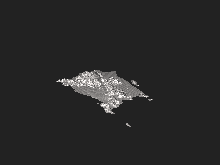Terrain rendering
Terrain rendering covers a variety of methods of depicting real-world or imaginary world surfaces. Most common terrain rendering is the depiction of Earth's surface.

It is used in various applications to give an observer a frame of reference. It is also often used in combination with rendering of non-terrain objects, such as trees, buildings, rivers, etc.
There are two major modes of terrain rendering: top-down and perspective rendering. Top-down terrain rendering has been known for centuries in the way of cartographic maps. Perspective terrain rendering has also been known for quite some time. However, only with the advent of computers and computer graphics perspective rendering has become mainstream.
Perspective terrain rendering is described in this article.
Structure
A typical terrain rendering application consists of a terrain database, a central processing unit (CPU), a dedicated graphics processing unit (GPU), and a display. A software application is configured to start at initial location in the world space. The output of the application is screen space representation of the real world on a display. The software application uses the CPU to identify and load terrain data corresponding to initial location from the terrain database, then applies the required transformations to build a mesh of points that can be rendered by the GPU, which completes geometrical transformations, creating screen space objects (such as polygons) that create a picture closely resembling the location of the real world.
Texture
There are a number of ways to texture the terrain surface. Some applications benefit from using artificial textures, such as elevation coloring, checkerboard, or other generic textures. Some applications attempt to recreate the real-world surface to the best possible representation using aerial photography and satellite imagery.
In video games, texture splatting is used to texture the terrain surface.
Generation
There are a great variety of methods to generate terrain surfaces. The main problem solved by all these methods is managing number of processed and rendered polygons. It is possible to create a very detailed picture of the world using billions of data points. However such applications are limited to static pictures. Most uses of terrain rendering are moving images, which require the software application to make decisions on how to simplify (by discarding or approximating) source terrain data. Virtually all terrain rendering applications use level of detail to manage number of data points processed by CPU and GPU. There are several modern algorithms for terrain surfaces generating.[1][2][3][4]
Applications
Terrain rendering is widely used in computer games to represent both Earth's surface and imaginary worlds. Some games also have terrain deformation (or deformable terrain).
One important application of terrain rendering is in synthetic vision systems. Pilots flying aircraft benefit greatly from the ability to see terrain surface at all times regardless of conditions outside the aircraft.
See also
- Geomipmapping
- Geometry Clipmaps
- ROAM (Real-time optimally adapting mesh)
- Terrain cartography
References
- Stewart J. (1999), “Fast Horizon Computation at All Points of a Terrain With Visibility and Shading Applications”, IEEE Transactions on visualization and computer graphics 4(1).
- Bashkov E., Zori S., Suvorova I. (2000), “Modern Methods of Environment Visual Simulation”, In Simulationstechnik, 14. Symposium in Hamburg SCS, pp. 509-514. Europe BVBA, Ghent, Belgium,
- Bashkov E.A., Zori S.A. (2001), “Visual Simulation of an Earth Surface by Fast Horizon Computation Algorithm”, In Simulation und Visualisierung, pp. 203-215. Institut fur Simulation und Graphik, Magdeburg, Deutschland
- Ruzinoor Che Mat & Norani Nordin, 'Silhouette Rendering Algorithm Using Vectorisation Technique from Kedah Topography Maps', Proceeding 2nd National Conference on Computer Graphics and Multimedia (CoGRAMM’04), Selangor, December 2004. https://s3.amazonaws.com/academia.edu.documents/30969013/449317633605827_1.pdf?AWSAccessKeyId=AKIAIWOWYYGZ2Y53UL3A&Expires=1505553957&Signature=7GA1T7nvGM5BOhLQ0OCELIKVYbY%3D&response-content-disposition=inline%3B%20filename%3D3D_Silhouette_Rendering_Algorithms_using.pdf%5B%5D